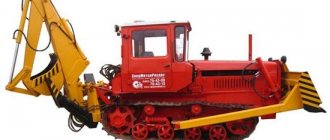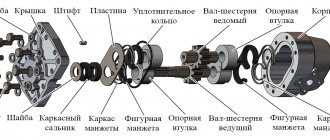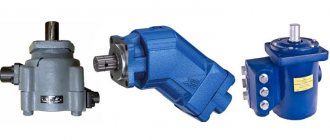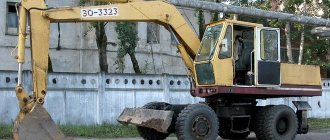A grab is a load-handling device used for lifting mechanisms when moving bulk materials, lumber and other cargo. In addition to loading and unloading, they are used when performing various excavation works - soil development, digging pits, cleaning reservoirs. The main parameter of lifting equipment is its lifting capacity. Loads are classified into groups based on bulk density - from very light to heavy. The size of the materials being moved is also taken into account (fraction for bulk building materials). Let's take a closer look at what a grab is and how it is used depending on its type.
Types of grabs
A grab is equipment for lifting machines, and in itself does not represent a mechanism for lifting loads - it is only an element of a machine (crane or other system). A grab can be a part of lifting equipment or its working part. Grabs are divided into several groups: Rope. Lifting and/or closing devices installed on cranes and similar equipment. The clip is attached to the traverse by means of a lock. With a rigid suspension. These are driven lifting devices (motorized) and multi-jaw ones. Let's find out in more detail what a rope and drive type grab is.
Rope grabs - what are they?
Rope lifting devices allow quick replacement and can be installed on various cranes. The following types are distinguished:
- Single-rope . Single-rope equipment includes equipment that is open in the initial position, and the lowering winch lowers the ropes. When the lock is activated, it is connected to the traverse. Next, the load is lifted and transported to a specified distance.
- Double-rope . The two-rope system has separate lifting and closing ropes. It should be noted that there is independent control of the winches for each rope for the drum.
- Three-rope, four-rope . Multi-rope ones differ in the number of winches. The drive is carried out separately for each rope when capturing, lifting and lowering loads. Multi-rope systems are mainly used for complex loads. Equipment with a single rope or a motor-driven gripper is more often used.
Operating rules
On the side chains, a hand grab is lowered into the well to the very bottom. At the same time, his “jaws” are opened to the maximum. When it reaches the bottom (this can be felt by the weakening of the chain tension), it is lifted by the central chain or cable, and the bowls automatically close under their own weight, scooping up the silt.
To pull the structure out, significant force is required. After being lifted, it is emptied and lowered into the well again - until the bitter end.
Related video: How to make a grab with your own hands
What are drive grabs?
Drive-type (motor) models are distinguished by the presence of a winch and support ropes to increase the stability of the structure. The advantages of grabs with jaws of this type include the following:
- Small dimensions compared to rope models. This is especially important when carrying out work in limited areas.
- Various drive designs. The center of gravity can be either below or above. The jaws of the drive mechanism can be 1, 2, 3 or 4 jaws. The capture is carried out in the same way as in the case of rope equipment.
DIY process
You can make a grab yourself, saving on the purchase or rental of expensive equipment. In terms of efficiency, a homemade grab for cleaning wells will be no different from a mechanized one, since sludge is a soft substance, which is also in a semi-liquid state.
Required material
To make the device you will need:
- steel sheet 2 mm thick (any one will do, for example, the common ST3);
- two steel pipes about 60 mm long, one of which fits freely into the other, but does not dangle;
- a chain or steel cable three times longer than the depth of the well, plus 1.5–2 m for reserve;
- welding machine, electrodes and welder’s mask;
- additionally - a drill, a grinder for metal, mounting bolts (you can do without them).
Structurally, any homemade grab consists of two toothed buckets, which, when closed, form a semicircle when viewed from the front. They are connected to each other by brackets welded to a drum made of pipes inserted into one another - the first bucket to the outer pipe, the second to the inner one. Additionally, ballast is welded onto the bucket plates, approximately 5 kg on each side. One chain is wound on a drum, other chains or cables are threaded through the eyes on the plates - they open the “jaws”.
Step-by-step instruction
Construction process:
- For a manual grab with a capacity of 1 bucket, a steel plate 550 mm long and 220 mm wide is sufficient. It is cut into 2 equal parts, and the cut either immediately goes in a zigzag, forming teeth, or the strips with teeth are welded subsequently.
- On the first bucket, the teeth should be at the end of the plate, on the second, they should be welded on the outside so that when closed they overlap, one on top of the other.
- For the sides, trapezoidal plates with a height of 220 are taken. They are welded to the main plates, which will form a sliding bottom, with a distance of 50 mm from the line of the jagged edge of the side. In this case, the side plates are butt-welded to the first bowl, and to the second - from the outer edge of the side, so that when closed they overlap one another.
- Ballast is welded from below or to the side.
- After this, brackets or “ears” are cut out of the remaining metal, 2 for each half of the sliding bucket. They are welded to the narrow part of the trapezoidal sidewalls.
- The hinge is made from two metal pipes. The smaller diameter tube should protrude slightly from the larger one.
- Thread the hinge between the halves of the “mouth”. A bowl of smaller diameter is welded through “ears” to the outer pipe (so as not to catch the inner one by welding), a bowl of larger diameter is welded to the inner pipe.
- They check. The structure should move freely, the toothed plates should close, the “jaws” should slightly overlap one another.
- The main chain is welded or otherwise attached to the drum. In both bowls, holes are made on the side opposite to the teeth, into which chains or cables are also threaded (can be welded or attached differently).
- The do-it-yourself grab bucket is ready.
Closing type
In a grab, the jaws can be closed in different ways. In general, the jaw mechanism works as follows:
- Lowering. The bucket is lowered (dropped onto the load, which is necessary for complete immersion in the mass - this is especially true for bulk cargo).
- Capture. The lifted load is captured by the lock - the jaws close together.
- Climb. A drum with a winch raises the closed jaws when winding the cable to the required height.
- Unloading. The bucket is lowered to the required platform with the lock opening.
The stages of loading and unloading operations differ depending on the type of equipment - for each option, taking into account the type of drive mechanism, the sequence of operator actions will be different.
Features of operation
It is very easy to work with such a grab. The central chain is wound onto the hoist drum. The rest are controlled manually. Next, we simply lower the grab into the well, but just before the water, the descent must be continued on the side chains. This is necessary for the grab to open. After it has completely sunk to the bottom, it rises up behind the central chain. Then it is simply pulled out and cleaned of silt.
After use, it is best to dry the grab and store it in a dry place, as bare steel can be severely damaged due to corrosion. The video shows the process of cleaning a well with a hand grab:
Number of jaws and grip type
Depending on its purpose, the grab can have up to 8 jaws. Their appearance differs depending on their purpose. The following types of grips are distinguished:
- Bucket-shaped. They are used for digging, mining and other earthworks. Can be used when digging pits.
- Pincer-like. They are used for loading and unloading timber, piece oversized cargo - for example, metal structures. The ideal solution for loading and unloading lumber.
- Forked. Necessary in the agricultural industry when working with hay, silage and similar materials. Optimal for loading hay rolls and other loading and unloading operations in the village.
Special grabs
Traditionally, the jaws close at the same time. But when any jaw is closed and blocked, all other elements of the lifting mechanism stop working. To solve this problem, independent convergence is used. There are also options with an individual drive - in this case, unevenness when closing is eliminated.
Main characteristics
Classified according to the following criteria:
- Capacity. The volume of cargo in cubic meters that the equipment can transport.
- Load capacity. The maximum load weight, taking into account its own weight, that is permissible for this equipment (indicated separately for the equipment and the lifting system).
- Dimensions. Indicated on the passport in both open and closed states. This also includes mass, taking into account all structural elements, including containers.
- Drive, number of jaws. There are equipment with rope, hydraulic drive, 2-8 jaws.
When choosing, take into account the overall dimensions of the lifting system. The grab can be rotated around an axis using a rotary unit. This option is optimal when working with container cargo, when transportation is required in limited space. The rotary installation is also useful in the case of work in a seaport or at a railway sorting, when there is no free space for loading and unloading operations. In such situations, when rotating the site, it is possible to reduce the area for loading and unloading and reduce the cost of work. The rotary system helps in cases where the equipment is used indoors. There are several factors to consider when choosing loading equipment:
- The materials to be worked with are various sizes for crushed stone, coal, wood chips.
- The carrying capacity of the supporting machine must be taken into account when loading and unloading at transshipment points in seaports, sawmills, and railway stations.
- Container dimensions - it is necessary that the volume of the jaws corresponds to the container into which unloading is carried out (wagon, container, box). Otherwise, damage to the shipping packaging and increased loading and unloading time may occur.
An equally important criterion when choosing attachments for lifting equipment is bulk density. Wood chips, natural stone, construction waste, and timber require different designs.
How to make it yourself?
A manual grab is very easy to make with your own hands. This requires a minimum of time, details and skills, and most importantly, under certain conditions there may be no financial costs at all.
Materials
Steel 2 mm thick is required. Two pipes of different diameters: one should fit and rotate freely into the other. It is also necessary to get a chain, the length of which should be such that the chain folded 3 times is enough for the entire well with a margin of about 2 meters.
Of the tools, only a welding machine and a cutter will be enough. Nothing else will be needed. Drawing of a grab for cleaning a well
Step-by-step instruction
To make a manual grab for cleaning a well, you must follow the instructions:
- The first step is to take a steel sheet and cut a plate 550 mm long and 22 mm wide. Next, this plate must be divided into two parts, but cut them not in a straight line, but in a zigzag. The result should be teeth. A length of each tooth of 15 mm will be sufficient.
- Now you need to make the sides. However, when cutting them, it should be taken into account that the bottom plates should not be positioned horizontally. There should be an angle of about 15 degrees between them and the ground. For the sides at the highest point (the center of the grab), 80 mm is enough.
- We cut out plates 40 mm wide and 220 mm high. We retreat 5 cm from the edge of the front part of the side and weld the plates so that the two on one side meet in the center of their edge.










